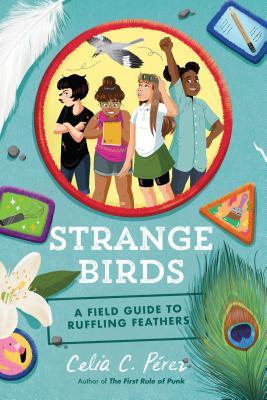Strange Birds: A Field Guide to Ruffling Feathers, Celia C. Perez
Middle Grade Fiction
Reviewed by Kimberly Christensen
 In Sabal Palms, Florida, many girls join the Floras, a service organization begun in the early 1900s by some of the founders of the city. Even though her grandmother was a proud Flora, Lane has no desire to join a group with rules and attitudes from another century. But Lane, who recently moved to Sabal Palms, also wants to find a group of friends. She leaves notices for a secret club meeting at her local library, hoping that chance will bring the right kind of girls to a secret meeting in her treehouse. She also sneaks an invitation into the backpack of a known girl, Ofelia, the daughter of her grandmother’s assistant.
In Sabal Palms, Florida, many girls join the Floras, a service organization begun in the early 1900s by some of the founders of the city. Even though her grandmother was a proud Flora, Lane has no desire to join a group with rules and attitudes from another century. But Lane, who recently moved to Sabal Palms, also wants to find a group of friends. She leaves notices for a secret club meeting at her local library, hoping that chance will bring the right kind of girls to a secret meeting in her treehouse. She also sneaks an invitation into the backpack of a known girl, Ofelia, the daughter of her grandmother’s assistant.
When meeting day arrives, four girls gather: Lane, artist and provocateur; Ofelia, budding journalist; Aster, a homeschooled girl with a passion for cooking; and Cat, an avid birder who is actually a member of the Floras but wants out. Each girl has a different family structure, socio-economic status, and ethnic background, and each one has struggled to find her place in the Sabal Palms community. So when they come together, the girls are awkward, shy, and uncertain about how to form a group.
Lane keeps trying, and soon it becomes clear that Cat–the birder–is going to provide them with the bonding experience they need. Cat, whose mother and three sisters were all Floras, wants to leave the organization because of a hat, and not just any hat, but the hat worn by the girl who is crowned Miss Floras. The problem is, the hat is a relic from the founding of the Floras and is made with feathers from birds that were hunted into extinction for their plumage. Cat can’t be part of an organization that wouldn’t renounce such a legacy, and when she tried to bring it up at a meeting, the troop leader wouldn’t consider her views. Now Cat’s ditching meetings, hiding it from her family, and hoping to change the troop leader’s mind.
As the other girls join Cat’s cause and brainstorm ways to raise awareness about the birds, they discover their identity as a group. They also begin to open up about their individual lives, making friendship possible. Out of their joint creativity, they hatch several plans to bring attention to the hat and the need to move on from hundred-year-old attitudes towards animals and the environment. The troop leader manages to thwart them several times, but in the end, the girls prevail with the help of some of the Floras. The girls example and their willingness to speak up about what matters to them has a ripple effect throughout their community.
Perez does a masterful job of telling a story with an interesting main plot while interweaving several subplots and life lessons into the story. For example, as the girls explore the question of “what’s worth fighting for?” they also wrestle with the costs of activism, including how getting caught would impact them unequally. Ofelia, the daughter of immigrants, would likely lose her overprotective parents’ trust and with that, the chance to go away to camp. Aster, who is African American, might face unequal treatment at the hands of the police. Lane and Cat, who are lighter skinned and wealthier, recognize that they have less to lose by trying to raise awareness by doing things like placing stickers on public property. As each girl weighs her priorities and wrestles with her conscience, the reader gains insight into the different reasons that people decide to become activists and what compels them to put their well-being on the line for a cause they believe in.
Additionally, the story introduces readers to the Migratory Bird Treaty Act of 1918, the reasons why it’s an important law, and the impact of human activity on bird populations. As women were central to its passage, it serves as an important framework and lesson for more modern young women who are figuring out what they believe in and whether or not its good to raise a ruckus for their cause.
The multiple perspectives in the book, as well as the interweaving of internal and external risks, make Strange Birds a compelling and powerful read. Five of five stars.